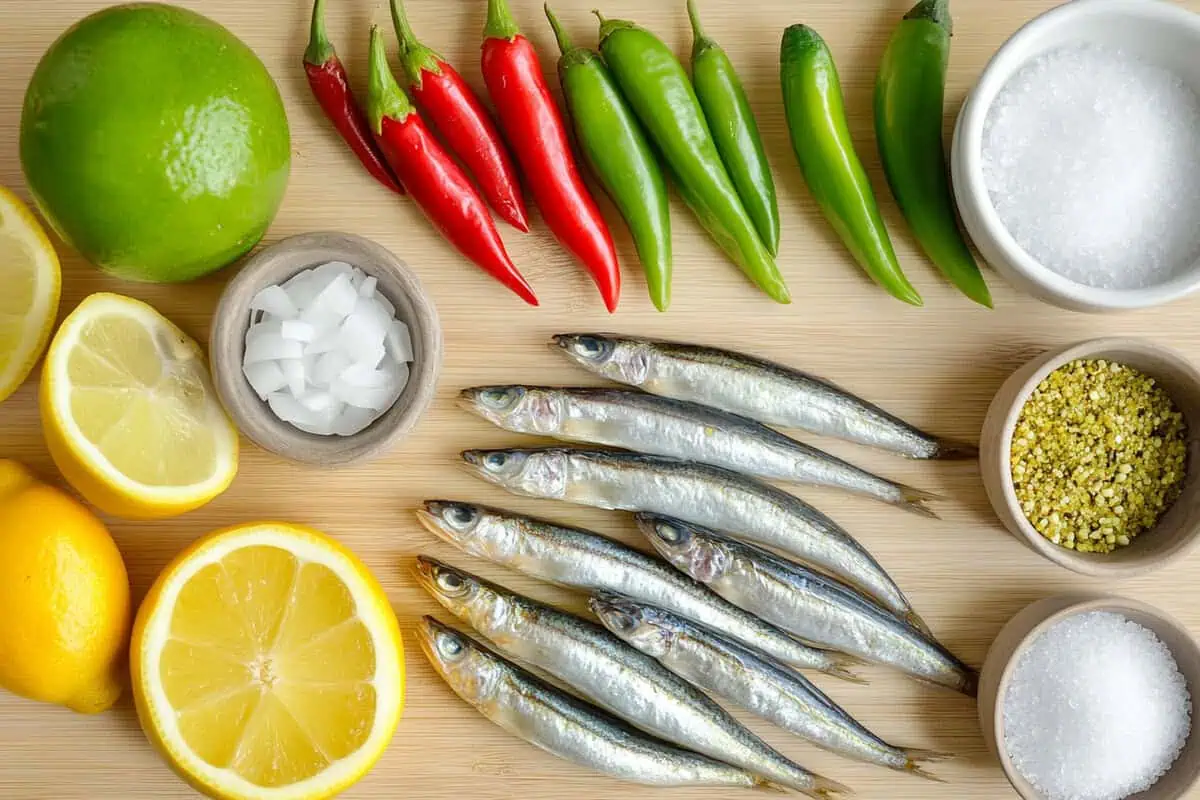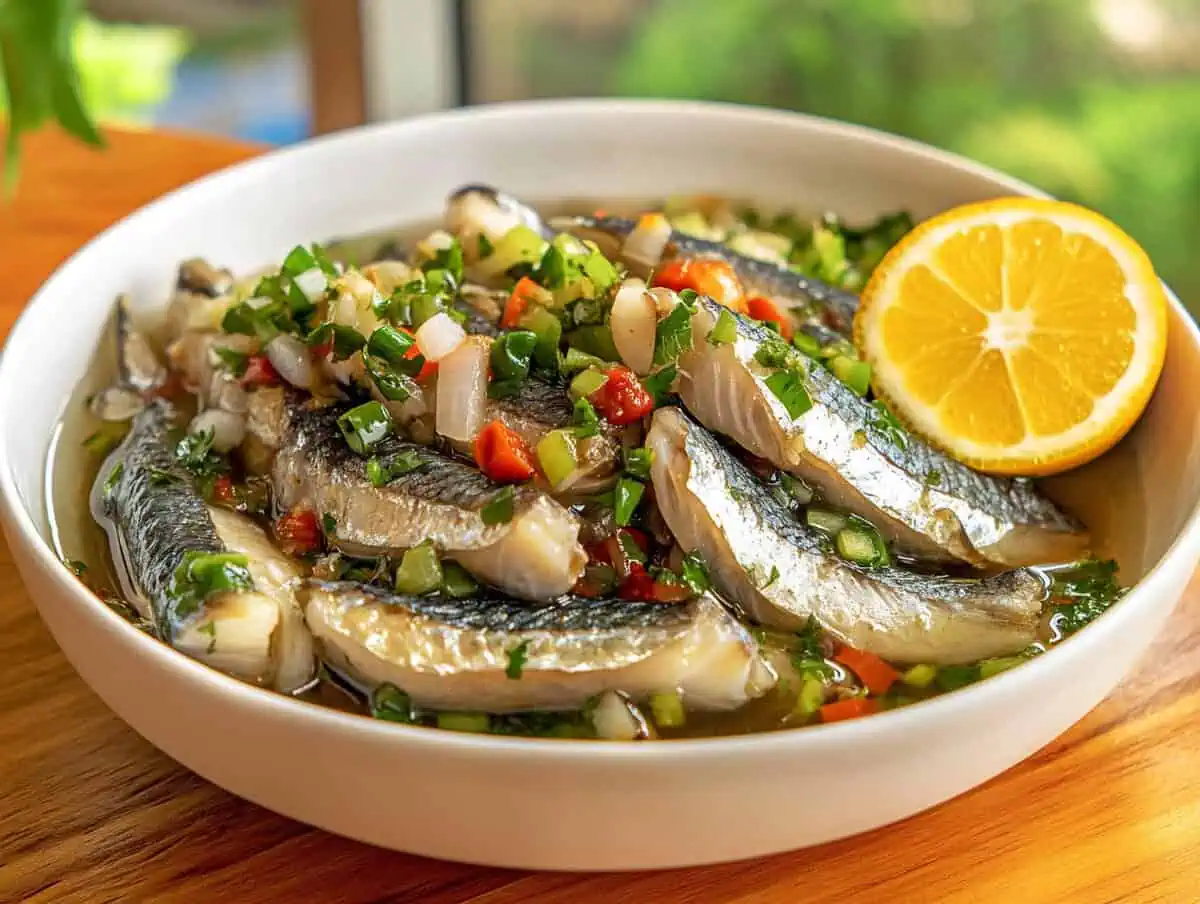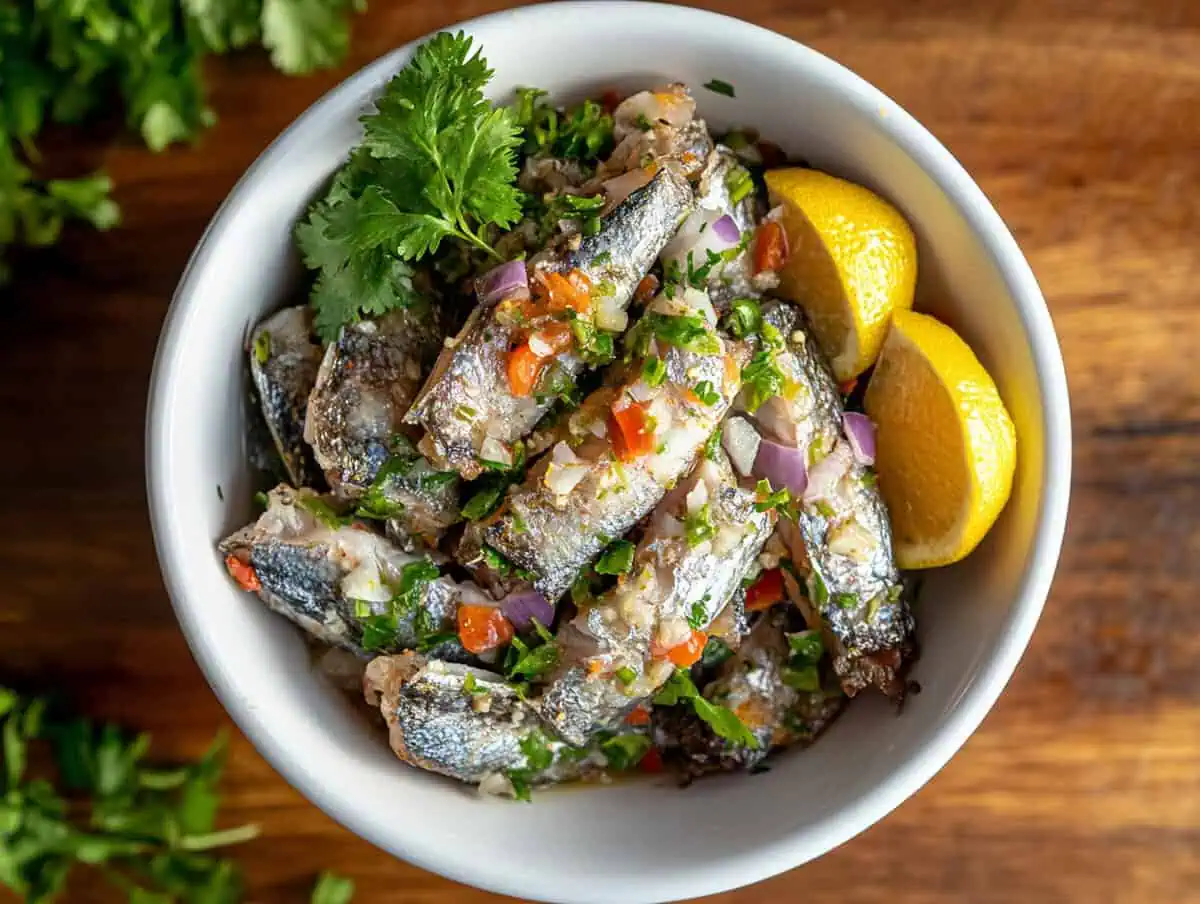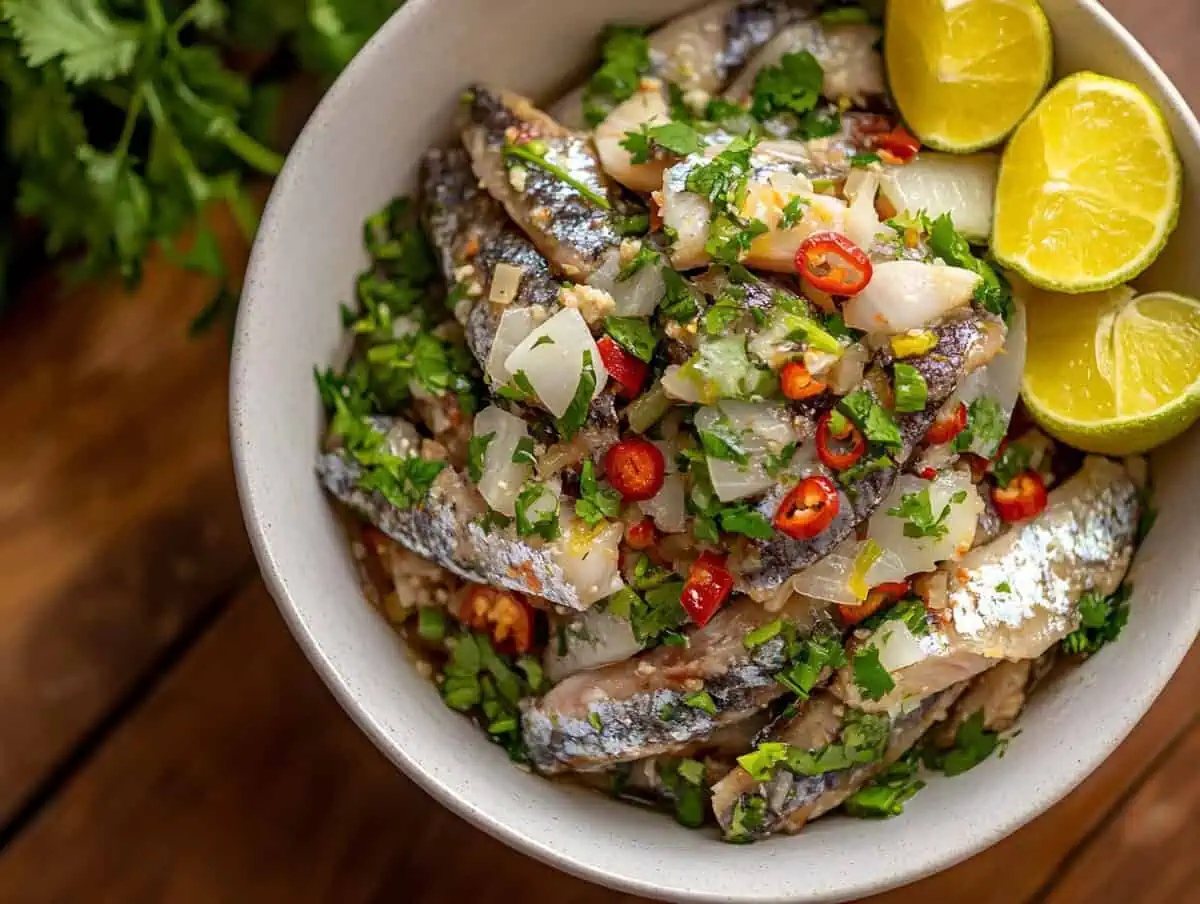Today I'm sharing one of my absolute favorite Filipino recipes - Kinilaw na Dilis. This refreshing dish transforms fresh anchovies into a vibrant, tangy ceviche that's perfect as an appetizer or paired with an ice-cold beer.
The combination of citrusy calamansi, spicy chilies, and aromatic ginger creates a flavor explosion that will transport you straight to the Philippines! I've been making this recipe for years, and it never fails to impress my family and friends.
The best part? No cooking required, just fresh ingredients and a little patience while it chills.
What is Kinilaw na Dilis?
Kinilaw na Dilis is a Filipino-style ceviche made with fresh anchovies (dilis). The fish is cleaned, deboned, and marinated in a mixture of calamansi juice, vinegar, ginger, onions, and chilies. The acidity from the citrus and vinegar "cooks" the fish without heat, resulting in a refreshing, tangy dish that's popular as an appetizer (pulutan) alongside cold beer or as a side dish with steamed rice.
Jump to:
Why You'll Love This Recipe
- It's incredibly refreshing and perfect for hot weather
- The balance of tangy, spicy, and savory flavors creates a taste explosion
- It requires zero cooking - just prep and chill!
- It's an authentic Filipino appetizer that impresses guests
- It pairs perfectly with cold beverages for entertaining
- It's budget-friendly but feels like a gourmet appetizer
Ingredients
Each component in this recipe plays a crucial role in creating the perfect kinilaw. The fresh anchovies provide a delicate seafood base, while calamansi and vinegar "cook" the fish and add bright acidity.
Ginger and onions contribute aromatic depth, chilies bring necessary heat, and the touch of sugar balances the sourness. This combination creates the authentic flavor profile that makes Filipino kinilaw so beloved and refreshing.

- ½ kilo (500g) fresh anchovies (dilis)
- 3 pieces long green chilies, sliced
- 3 pieces red chilies, sliced
- 2 thumb-sized ginger pieces, minced
- 1 medium onion, minced
- 5 calamansi, juiced (or substitute with 2-3 tablespoons lime juice)
- 3 tablespoons white vinegar
- ½ teaspoon freshly ground black pepper
- 1 teaspoon salt, or to taste
- ½ teaspoon sugar, or to taste
Equipment
- Sharp knife
- Cutting board
- Large mixing bowl
- Plastic wrap
- Small bowls for prepping ingredients
- Citrus juicer (for calamansi)
- Serving plate

How To Make
- Prepare the anchovies: Gently twist the head of each anchovy and pull to remove the innards. Squeeze the belly gently to remove any remaining innards. Pull the bone and tail to remove completely. Set aside the cleaned fish.
- Rinse thoroughly: Wash the cleaned anchovies again thoroughly under cold running water and transfer them into a large bowl.
- Combine ingredients: Add the minced ginger, minced onions, chopped green and red chilies, calamansi juice, and vinegar to the bowl with the anchovies.
- Season: Add salt, pepper, and sugar to taste. Mix gently until all ingredients are well combined.
- Chill: Cover the bowl with plastic wrap and refrigerate for at least 30 minutes to allow the flavors to meld and the acidity to "cook" the fish.
- Serve: Before serving, give the mixture a gentle stir. Transfer to a serving plate and enjoy as an appetizer, with hot steamed rice, or as a pulutan (finger food) with cold beer.

Tips from Lola's Kitchen
- Freshness is key: Always use the freshest anchovies possible, preferably purchased from the market on the same day you'll prepare the dish.
- Thorough cleaning: Take extra time to clean the anchovies properly, removing all innards, bones, and tails for the best eating experience.
- Balanced acidity: Adjust the amount of calamansi juice and vinegar based on your preference for sourness.
- Prep in advance: Kinilaw gets better as it sits in the refrigerator, so feel free to prepare it up to 2 hours before serving.
- Temperature matters: Always serve kinilaw chilled for the best flavor and food safety.
- Hand protection: Consider wearing food-safe gloves when cleaning the fish and handling chilies to protect your hands.
Substitutions
- Calamansi substitute: If calamansi is unavailable, use lime juice or a combination of lime and lemon juice.
- Fish options: While dilis (anchovies) are traditional, you can also use fresh tuna, tanigue (Spanish mackerel), or lapu-lapu (grouper) for a different version of kinilaw.
- Vinegar variations: White vinegar is traditional, but you can experiment with apple cider vinegar, cane vinegar, or rice wine vinegar for different flavor profiles.
- Heat level: Adjust the amount of chilies based on your spice tolerance, or substitute with bell peppers for a milder version.
- Add-ins: Some regions in the Philippines add cucumber, tomatoes, or green mangoes for texture and additional flavor.
Troubleshooting
- Fish tastes too "fishy": The fish might not be fresh enough. Always use the freshest catch and ensure thorough cleaning.
- Too sour: Add a bit more sugar to balance the acidity, or dilute with a tablespoon of water.
- Too mild: Add more chilies, ginger, or onions to enhance the flavor profile.
- Fish still looks raw: Ensure you've used enough acid (calamansi and vinegar) and allow it to marinate longer. The fish should turn opaque and slightly white when properly "cooked" by the acid.
- Watery mixture: If there's too much liquid, drain some off before serving or add more vegetables to absorb excess moisture.
Storage & Reheating
- Storage: Kinilaw na Dilis is best consumed on the day it's made but can be stored in an airtight container in the refrigerator for up to 24 hours.
- Not recommended for freezing: Due to the delicate nature of the dish and its raw preparation method, freezing is not recommended.
- Reheating: This dish is not meant to be reheated as it's a raw dish "cooked" by acid. Always serve chilled directly from the refrigerator.

FAQ
Is Kinilaw na Dilis safe to eat since the fish isn't cooked with heat?
Yes, when prepared properly with fresh fish and sufficient acid (lime/calamansi juice and vinegar), the acid denatures the proteins in the fish, effectively "cooking" it without heat. Always use the freshest fish possible and keep refrigerated.
Can I make Kinilaw na Dilis ahead of time for a party?
Yes, but not too far ahead. Prepare it 1-2 hours before serving for the best balance of flavor development and freshness.
What's the difference between Kinilaw and Kilawin?
While these terms are sometimes used interchangeably, Kinilaw typically refers to raw seafood marinated in vinegar and citrus juice, while Kilawin often includes pre-cooked ingredients like grilled pork mixed with the acid marinade.
What can I serve with Kinilaw na Dilis?
It's traditionally served as a pulutan (appetizer) with cold beer, but it also pairs well with steamed rice, fried dishes like calamares or crispy pata, or other Filipino favorites.
How can I tell if my anchovies are fresh enough for Kinilaw?
Fresh anchovies should have clear, bright eyes, shiny skin, and a fresh, clean ocean smell. They should be firm to the touch and not slimy. For the best quality, purchase them early in the morning from your local fish market.
Can I use dried anchovies (tuyo) for this recipe?
No, this recipe specifically requires fresh anchovies. Dried anchovies have already been preserved and won't work for kinilaw, which is a fresh-fish preparation.
How spicy is this dish?
The spice level can be adjusted to your preference by controlling the amount and type of chilies you use. Using more red chilies will make it spicier, while green chilies generally provide a milder heat.
Related
Looking for other recipes like this? Try these:

Kinilaw na Dilis
Ingredients
- ½ kilo 500g fresh anchovies (dilis)
- 3 pieces long green chilies sliced
- 3 pieces red chilies sliced
- 2 thumb-sized ginger pieces minced
- 1 medium onion minced
- 5 calamansi juiced (or substitute with 2-3 tablespoons lime juice)
- 3 tablespoons white vinegar
- ½ teaspoon freshly ground black pepper
- 1 teaspoon salt or to taste
- ½ teaspoon sugar or to taste
Instructions
- Prepare the anchovies: Gently twist the head of each anchovy and pull to remove the innards. Squeeze the belly gently to remove any remaining innards. Pull the bone and tail to remove completely. Set aside the cleaned fish.
- Rinse thoroughly: Wash the cleaned anchovies again thoroughly under cold running water and transfer them into a large bowl.
- Combine ingredients: Add the minced ginger, minced onions, chopped green and red chilies, calamansi juice, and vinegar to the bowl with the anchovies.
- Season: Add salt, pepper, and sugar to taste. Mix gently until all ingredients are well combined.
- Chill: Cover the bowl with plastic wrap and refrigerate for at least 30 minutes to allow the flavors to meld and the acidity to "cook" the fish.
- Serve: Before serving, give the mixture a gentle stir. Transfer to a serving plate and enjoy as an appetizer, with hot steamed rice, or as a pulutan (finger food) with cold beer.
Tips from Lola's Kitchen
- Freshness is key: Always use the freshest anchovies possible, preferably purchased from the market on the same day you'll prepare the dish.
- Thorough cleaning: Take extra time to clean the anchovies properly, removing all innards, bones, and tails for the best eating experience.
- Balanced acidity: Adjust the amount of calamansi juice and vinegar based on your preference for sourness.
- Prep in advance: Kinilaw gets better as it sits in the refrigerator, so feel free to prepare it up to 2 hours before serving.
- Temperature matters: Always serve kinilaw chilled for the best flavor and food safety.
- Hand protection: Consider wearing food-safe gloves when cleaning the fish and handling chilies to protect your hands.
The Story Behind Kinilaw na Dilis
Kinilaw is one of the Philippines' oldest cooking methods, dating back to pre-colonial times when coastal communities needed ways to preserve and enjoy fresh seafood without cooking over fire. This ancient preparation method is often considered the Filipino version of ceviche, though it developed independently from similar South American dishes.
In the beautiful coastal regions of the Philippines, particularly in the Visayas and Mindanao, kinilaw has been a staple for generations. Fishermen would prepare the freshest catch right on their boats, using native calamansi or other citrus fruits along with vinegar to "cook" the fish. This practical preservation method eventually evolved into the beloved culinary tradition we enjoy today.
Dilis (anchovies) became a popular choice for kinilaw because these small, abundant fish are readily available in Philippine waters year-round. The tiny fish are perfect for quick preparation since they require minimal cleaning compared to larger fish varieties. Their delicate flesh also absorbs the flavorful marinade beautifully, creating a harmonious balance of flavors.
What makes Kinilaw na Dilis truly special is how it showcases the Filipino talent for balancing contrasting flavors – the sourness of vinegar and calamansi, the heat of chilies, the pungency of ginger and onions, and the subtle sweetness that ties everything together. This balance reflects the Filipino palate's appreciation for layered, complex flavors.
Today, Kinilaw na Dilis remains a beloved pulutan (appetizer served with alcoholic drinks) across the Philippines. Whether enjoyed at beach-side restaurants, family gatherings, or local carinderia (small eateries), this dish continues to highlight the incredible seafood bounty and culinary heritage of the Philippine islands. When you prepare this recipe at home, you're participating in a centuries-old Filipino tradition that celebrates freshness, flavor, and the gifts of the sea.










Comments
No Comments